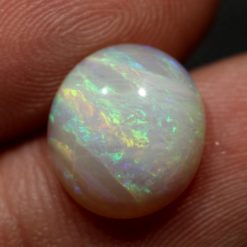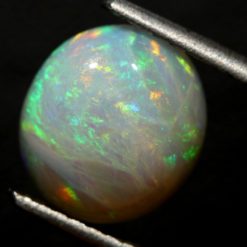No products in the cart.
Gemstone Information
Eric The Pliosaur – Australia’s Natural Wonder
Fossil finding has never been easy. Universities, as well as museums, spend quite a lot of money in the search for these ancient creatures. A very interesting fossil discovery over the years is Eric the Pliosaur. This fossil posses quite a few unique and interesting qualities. The fossil is left with a gorgeous rainbow play of color which happens when opalization takes place.
Although you might think this is the most interesting part of this story, the discovery, reconstruction and ownership which led to the rescuing and possession of the fossil is also very interesting. This fossil was saved from being used in jewelry and can now be found in the Australian Museum where it stays permanently.
This opal covered fossil was discovered by a miner in a town called Coober Pedy in Australia in the year 1987. When this happened, the miner decided to dig out the fossil for his personal interest. The seven-foot opal covered fossil was damaged in its fragile areas.

What is opal mining
Opal miming has to be one of the most dangerous types of mining to exist. It is one of the most distressed and pain causing mining option there is. An opal miner such as the one who stumbled on the Eric The Pliosaur usually tend to want to keep such things for themselves after all the hassle. The difference between a Pliosaur and a plesiosaur is the size of the neck and skulls. Pliosaurs tend to have larger skulls coupled with shorter necks in comparison to the plesiosaur. These creatures are not dinosaurs, although they did exist at the same time. Eric the Pliosaur is an amazing example of things that occur during a fossilization process. This process is basically the encasement of animals with the introduction of minerals into the bones in order to Create fossils.
Another rare sight is the introduction of opal into a fossil. Opalization is rarer than the fossilization process in the first place. This process usually leads to near-iridescent sheen. Eric was found in Coober Pedy, Australia which has been known for large opal deposits. Coupled with certain conditions, as well as location, it took millions of years on creating this Pliosaur wonder. Coober Pedy is also the location where the Virgin Rainbow was found.
Reconstruction of a Pliosaur and use for jewelry
Opal miners living in a small area such as Coober Pedy have little use for a fossil like this. Miners will be more interested in actually selling it as it contains an estimated $25,000 worth of Opal. But it is worth a lot more as a complete fossil. Due to this fact once the miner who discovered it dug it up, he quickly sold it to Sid Londonish, an Australian businessman for a high sum of $125,000 in Australian dollars. In today’s money that is a total of $230,000 in the United States (inflation considered).
This Australian businessman then decided to reconstruct the pliosaur and sought after the help of Paul Willis, an archaeologist, to help him in finding out the missing pieces of the fossil. It was Paul Willis who then gave this fossil the name it bears today “Eric”. Paul Willis gave this fossil the name from a Monty Python song. Paul discovered an opalized fish during the reconstruction process inside Eric’s stomach which they named Wanda.

Save Eric
Many years after the discovery of this fossil, Sid Londonish began having money problems as he spent quite a lot of money in the purchasing of fossils. The high cost that comes along with preservation and reconstruction of fossils eventually took a hard hit on him. Due to this reason, he decided that auctioning these fossils was a better idea than keeping them. And that he did, selling it off to the highest bidders in an open auction. This auction attracted a lot of people from all over the world from jewelers, a private collectors and even international museums. These investors such as jewelers where looking forward to breaking Eric down and selling it as pieces of jewelry.
Australians came together to ensure Eric the Pliosaur never left home and stayed in Australia where it belonged. A science series shown on television in Australia called “Quantum” began a campaign which was titled “save Eric”. After getting donations from numerous sponsors as well as profit made from fundraising by the Australian school children, they were able to come up with a total of $450,000.

The Australian museum also took part by giving their own share of a large donation and together, they could purchase the Pliosaur from Sid Londonish in the year 1993. Due to the considerable and beautiful act, Eric the Pliosaur is on display at the Australian Museum. So if you’re ever around the Australian Museum, go and see the beauty of Eric for yourself. He wasn’t just a rare fossil but brought the people of Australia together for a cause.
Conclusion
Fossilization is truly a process that is not frequent in occurrence. It is usually brought about by accidents of animals encasing themselves in stone or into bones through a chemical process. This, in turn, creates the fossils we know of. And even a rarer occurrence is the infusion of these animals into opals Which are considered semi-precious. This creates an almost bright sheen to it.







